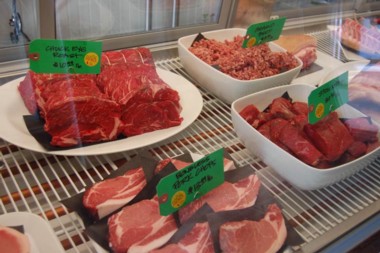“The high cost of cheap chicken: 97 percent of the breasts we tested harbored bacteria that could make you sick.” That headline on a Consumer Reports article published in December is all too typical of press reports about chicken and other meat from mainstream producers these days—and not just these days.
It’s been a while since the Mad Cow scare exposed the fact that beef cattle were sometimes fed contaminated cow parts. And that particular Consumer Reports headline doesn’t bring up the alarming issues of antibiotics and hormones in meat.
Then there’s the matter of cruelty in the ways animals are raised and slaughtered: calves raised for veal in cages so small they can’t stand up; pigs whose tails and genitals are chopped off without anesthesia while they’re still living; baby chicks smothered in plastic bags.
Consumers care about cruelty, and they certainly care about the purity and quality of meat. The result is a growing trade in sustainably raised, locally grown meat. In the Valley and neighboring Vermont, as well as other parts of the country, there’s a lot of interest in how food is produced.
“People are concerned about how animals are raised, they’re concerned about antibiotics, and those concerns have led people in lots of different regions to be looking at their meat,” says Margaret Christie of CISA (Community Involved in Sustaining Agriculture), a South Deerfield-based organization that supports Valley agriculture. Noting that the second annual New England Meat Conference will be held in Concord, N. H. March 7 and 8, Christie added, “It’s exciting that people are getting together and talking to each other.”
It’s not easy to quantify the increase in the amount of meat grown and sold locally, but there are indicators. “Ten years ago I don’t think there were any meat CSAs,” says Christie. “There were none and then there was one, and now I think there might be as many as eight.” (CISA’s website, www.buylocalfood.org/buy-local/find-local/csa-farm-listing, lists 10. Or check EatWild’s list of sustainably run Massachusetts meat farms at www.eatwild.com/products/massachusetts.html).
Andrea Stander is executive director of Rural Vermont, an organization that monitors and supports agriculture in the Green Mountain State, where there’s a strong tradition of locally raised meat being sold by farmers to neighbors. Rural Vermont helped shepherd a law through the Vermont Legislature that supported that tradition by allowing customers to buy up to three cows, 10 pigs or 25 sheep or goats at a farm and have them slaughtered on that farm by itinerant slaughterers. Demand is growing for locally raised meat, says Stander, who adds that the meat is available through farmers’ markets, but “more and more is being sold through coops… What I know anecdotally from our local coop in Montpelier is, they can’t keep it in the cooler.”
In Amherst, too, a newly opened coop is offering meat formerly available chiefly through farmers’ markets. Manager Al Sax describes the new All Things Local cooperative store on North Pleasant Street as “a farmers’ market that’s open six days a week instead of four hours.” All Things Local stocks meat from half a dozen Valley farms, including kinds and cuts of meat that aren’t easy to find in mainstream grocery stores.
“This is the full animal here, goat shanks, fatback, rack of lamb, chorizo,” Sax explained. “Some small producers are going to have the opportunity to try things out… I want pints of frozen chicken livers from Diemand Farm because I know how they raise their chickens and I know they’ll be good.” Sax added that when customers buy chicken livers in mainstream stores, they “don’t know what [the chickens] have been eating.”
At All Things Local, the Advocate talked to shopper Taylor Burt about why he was looking for locally raised meat. “I know how the animals are raised,” said Burt, pointing to the informational stickers on the doors of the meat case. “I love supporting the local economy, maintaining working landscapes. I’m concerned about the animals themselves being appropriately treated, as well as the quality of nutrition.”
Even newer on the scene than All Things Local is Sutter Meats, a butcher shop started up in Northampton for the purpose of offering sustainably raised meat. Butcher Terry Ragasa, who owns Sutter with his wife, Susan Ragasa, said the two moved from Brooklyn to Northampton after looking at Ithaca, Philadelphia and parts of California because of the educated consumers here, and in particular because of CISA, which helped them meet local farmers.
“[CISA has] really set out to help people be close to their food sources,” Ragasa said. “It is unusual in that they have such a hardworking staff of people. They’ve done a lot of their homework and they really do care about the community. They have a larger staff than the similar programs in other towns. Most other places, they’re based out of a university where their funding is limited, and those companies don’t necessarily have the same ideals that these programs are set up to achieve.”
Another important part of the picture for the Ragasas is the Adams Farm slaughterhouse in Athol. Developing a meat industry in a region takes more infrastructure than bringing vegetables to market: slaughtering facilities are key, and, in this area, few. Massachusetts’ one other slaughterhouse, Blood Farm in Groton, burned down Dec. 29. Other slaughterhouse services are available, but they require Valley farmers to travel to Vermont or eastern New York.
(For poultry, not yet as plentiful at farmers’ markets as meat from larger animals, the Belchertown-based New England Small Farms Institute makes available a mobile processing unit that can slaughter 400 birds a day; it’s offered for use by farmers who raise more than 1,000 but fewer than 20,000 chickens or 5,000 turkeys a year.)
Adams Farm burned down in 2006, but was rebuilt; in 2012 it processed 26,080 animals, according to manager Ed Maltby, up from 24,830 the year before. At Adams, the handling system is designed to minimize stress for the livestock, and “because of the size,” says Maltby, “it’s possible to track each person’s animals.” In other words, instead of simply bringing in a certain number of pounds of live meat and getting back a certain number of pounds of slaughtered product, as customers do at slaughterhouses with large volumes, at Adams the meat customers get back is from their own animals. Adams’ customers run small operations and may bring in only one or two animals, or 60 to 70 at most, he says. Adams Farm has a USDA inspector on site.
Ragasa, who uses Adams Farm’s slaughtering services, says the way Adams Farm treats animals is good for them and for the consumer. “The animals aren’t pent up,” he explains. “They separate them by the different breeds. They’re not confining them in an enclosed space for too long. That transitional time is important for them to have a more relaxed slaughter. You get a better meat that way because adrenaline can cause what’s called a dark cutter [with sticky, tough meat with a dark purplish color]. It has an unpleasant texture and taste.”
Before the recent very visible increase in the number of meat farms, the Valley had some growers who produced meat; their products could be found here and there in local independent grocery stores like Serio’s in Northampton, which sold beef from River Rock Farm in Brimfield. River Rock Farm, located on land that had been farmed for over 100 years, added beef cattle in 1998 and “became a real beef livestock farm around 2001,” according to owner Charlie Sayer, who worked the farm with its first owner, Jon Konove, in the 1990s. After Konove died in a truck rollover in 2006, Sayer moved back from Colorado to take over the farm at the behest of Konove’s parents, he said.
River Rock’s animals are raised with no artificial growth hormones, growth stimulants, antibiotics or artificial feed additives. Serio’s was River Rock’s first outlet in Northampton, its “foothold for the farm to expand business out into the Connecticut River valley,” Sayer recalls. Now River Rock sells a lot of meat in the Boston area.
“I think people realize that we have a superior product, much tastier than boxed beef,” Sayer says. “It’s raised in a humane way, and more people are realizing that the carbon footprint of food is crazy. When animals are fed strictly corn, the animals get sick, so they have to be fed antibiotics, and that’s an issue. Corn adds a lot of fat to animals.” Sayer says cattle at River Rock eat grass most of the year and hay in the winter. Then for three months before slaughter they get a ration of locally milled corn that Sayer says “allows us to age the beef.”
River Rock now has “more demand than supply,” says Sayer, adding that h trimmed down River Rock’s herd from 175 head eight or nine years ago to 100 today so each animal would have enough pasture with good grass.
River Rock Farm is an example of an enterprise that started because of the wish of one man—Jon Konove—to raise beef cattle in a region not known for beef production, and within a relatively few years became part of a movement back to small-farm meat production. Going forward, that movement may prove to be more important than farmers or their customers know. It’s not only the problems of contamination that give consumers pause about the meat supply as we know it; even larger problems loom.
The availability of meat from the large national suppliers depends on the supply and cost of fuel for the transportation system, and the productivity of the country’s largest meat production facilitities depends on another commodity that’s in short supply: water. Between 2011 and 2013, Texas ranchers lost 15 percent of their livestock because of drought. In the Midwest, the Ogallala Aquifer, which underlies vast areas of ranching and corn-growing land, is being overdrawn. A Kansas State University study has shown that at the present rate of usage, the aquifer would be depleted by 69 percent by 2060.
Some day the supply of local food, including meat, in the Valley may be more than just an a source of pleasure for those who prefer the flavor of steak and chops from grass-fed animals. It’s part of the Valley’s food security. “Supporting local food producers contributes to our having a more resilient local food economy that is able to support us when there are threats to the larger system,” Christie says. “Strengthening the local system and the regional system is good for us no matter what happens.”



